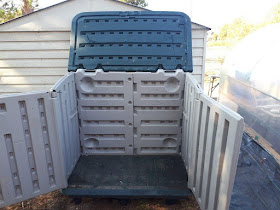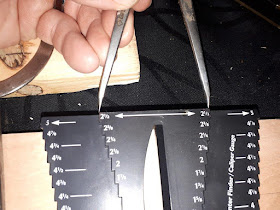For the last little while been sorting, de-rusting and taking inventory of drilling tools and implements.
I have been working out of that till for a few years now, time to address some shortcoming.
How my Boring till looks like today.
Some of the tools boards I am making shown
at the bottom
Don't get me wrong, it works fine as is, but I have a multitude of small accessories required and lots of wasted spaces at the bottom, which keep accumulating stuff. Time for some holders.
As usual when I go about designing something, I first round up the usual suspects. Drill bits and assorted implements used, in this case.
Then I sorta separated them in what I thought would be best ?? In other words it had to fit what ever piece of wood I'm using :-)
I have this plastic drill index box on the right hand side , which I find very useful to quickly find out the size of some errant bits, easier than trying to decipher small markings. So it has to stay.
On the other side I want to relocate my awls holder off the current shop wall, that left me with a given dimension for a board.
Starting to populate board with various bits and accessories
in some logical manner.
Then I decided that maybe I can get away with squeezing another narrow strip up front :-)
I was going to make it to fit the length of the two other,
but decided not to cut short and filled it up.
This is what my final layout looks like.
The empty spaces are for two missing sizes of Yankee adapters
and two sizes of VIX bits, on order from LV :-)
In hindsight not sure what I was thinking about when putting in the circle cutter.
Solely used on Drill press.
While I am at it, may as well organized the same variety of bits.
Got all the Jennings and Irwins I could find together.
Now to assemble sets.
Complete sets of Irwins from No 4 (1/4 in) to No 18 (1-1/8 in)
The whole set fit within 14 inches.
So maybe two rows of 7 inches?
Made boards with the spacings figured around earlier for the stem.
Then attempted to make spacers sizes for the bits themselves.
It quickly revealed which ones are in dire need of sharpening.
It also shows how two rows behind each other would look.
It is a bit thicker than needed but I was going to cut four half strips from it.
That bit shown in progress of being unwrap for the first time
was a disappointing surprise. Factory sharpened, undamaged,
choked up, did not cut through.
I was not surprised to find some bits in need of sharpening, some of these came out of Evaporust before becoming shiny objects again. But the New Old Stock one got me surprised.
Nice factory edge but the only thing that is obviously different from the old ones is that the grind on top of the routers is much more vertical. Guessing the ease at which angle the grinder used fit within?
The resulting cutting edge act more like a scraper than a incline edge lifting up the wood chips. It does not go far before choking.
Apparently more recent Irwin auger bits were not individually hand sharpened and tested as they used to?? Probably automated grinding operation. All good or all bad, pick one... machines can be so consistent :-)
Also made a smaller screwdriver holder with a piece of scrap from the above holders
Assortment of Stubby screwdrivers
R-L
Vaco reversible common/Phillips, Stanley Phillips No 2, Fuller Robertson No 1,
Benchmark Robertson No 0, Yankee ratchet common screwdriver
Th reversible besides the Yankee for size comparison.
And there was my recent marking gauges board, so if you were wondering were are they all going to fit in?? That space under the window.
Lots of wasted space and not easy to add remove holders on the wall.
Brace bits holder is wasteful. I like the idea but the supports need
relocating to be more efficient
My latest bright plan for that space is to lined it with about 4 or five rows of French cleats. Then I can add/remove to my heart content various holders.
So I will recycle some currently set up with hooks for peg boards by attaching the other French cleats in the back. Since the holders would be spaced out away from the wall the thickness of the French cleats are, I also gain some clearances for my fingers behind the tools mounted.
One examples of many holders set up for pegboards mounting.
So in the end, the Boring till is getting an upgrade, the wall under the window is getting re organized and my various drilling bits are getting organized and sharpen. Should keep me occupied for a little while.
The area in question, including under the boring till.
This exercise also highlighted some limitations of my current set up. I long lamented the lack of spaces for my banging objects AKA mallets, need another holder. I obviously need some chisels up front of bench. I rarely used my Rockler bench cookies at that bench, should also make some provision for holding the pair of cordless drills/driver. They are cordless so fit within a tail less shop :-)
They do get used a lot and need a home, which mean, will need to add an outlet nearby.
Also seriously thinking about removing the built in bench on the other wall. Right now it is overflowing with wood which need to go somewhere else. That would give me space for a shaving horse and a pole lathe, if I ever get the time for it??
Meanwhile, finally got the door out of my garage and installed.
I can finally now proceed with the deck and carpet replacement in dining room/living room
After Christmas.
The door to the basement is also installed, big improvement. NO draft, more light and noticeably warmer in the corner.
My windows I previously fixed are now clad in aluminum. Will never have to touch them again.
Remains to put back the shutters after they are cleaned, painted etc... In the Spring.
The Dove? I am an old Cold War warrior
Peace on earth Brothers and Sisters
And now that I can walk around the garage again, the sad shape of those poor neglected machines shows a lot of red rust. Not too alarming, but should be attended to soon...
Yes, it's overdue for some loving attention
That and I need to bring in 220 Volts service inside garage, service panel is at the other end of the house, of course. As encouragement for me to resurrect my good old Unisaw, I treated her to a new miter gauge, my present from me for my birthday and Christmas. :-)
Its a miter gauge with a built in box jig and flip stop.
But Honey it was on sale :-)
The review that got me convinced to try it :-) Bought from banggood
Another review from Woodhaven
Being shipped, should be here before Christmas, but 220 wont happened before next year...
Bob, keeping busy, cause you know, now is not the time to end up on the naughty list :-)





























































